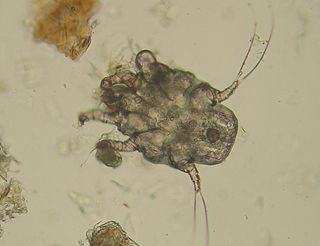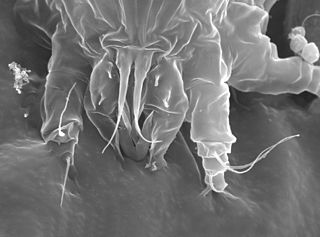
Arachnida is a class of joint-legged arthropods, in the subphylum Chelicerata. Arachnida includes, among others, spiders, scorpions, ticks, mites, pseudoscorpions, harvestmen, camel spiders, whip spiders and vinegaroons.

Mites are small arachnids. Mites span two large orders of arachnids, the Acariformes and the Parasitiformes, which were historically grouped together in the subclass Acari. However, most recent genetic analyses do not recover the two as each other's closest relative within Arachnida, rendering the group non-monophyletic. Most mites are tiny, less than 1 mm (0.04 in) in length, and have a simple, unsegmented body plan. The small size of most species makes them easily overlooked; some species live in water, many live in soil as decomposers, others live on plants, sometimes creating galls, while others are predators or parasites. This last type includes the commercially destructive Varroa parasite of honey bees, as well as scabies mites of humans. Most species are harmless to humans, but a few are associated with allergies or may transmit diseases.

The Acariformes, also known as the Actinotrichida, are the more diverse of the two superorders of mites. Over 32,000 described species are found in 351 families, with an estimated total of 440,000 to 929,000 species, including undescribed species.

Parasitiformes are a superorder of Arachnids, constituting one of the two major groups of mites, alongside Acariformes. Parasitiformes has, at times, been classified at the rank of order or suborder.

Mesostigmata is an order of mites belonging to the Parasitiformes. They are by far the largest group of Parasitiformes, with over 8,000 species in 130 families. Mesostigmata includes parasitic as well as free-living and predatory forms. They can be recognized by the single pair of spiracles positioned laterally on the body.

Astigmatina is a clade of mites in the superorder Acariformes. Astigmata has been ranked as an order or suborder in the past, but was lowered to the unranked clade Astigmatina of the clade Desmonomatides in the order Sarcoptiformes. Astigmatina is now made up of the two groups Acaridia and Psoroptidia, which have been suborders of the order Astigmata in the past. Astigmatina contains about 10 superfamilies and 76 families under Acaridia and Psoroptidia.

Cheyletidae is a family of mites in the order Trombidiformes. Some members are parasites of birds and mammals, causing cheyletiellosis, or "walking dandruff". Others are free-ranging predators which can be found in soil, forest litter, animal nests, and house dust, under tree bark, and on foliage.

Eriophyoidea are a superfamily of herbivorous mites. All post-embryonic instars lack the third and fourth pairs of legs, and the respiratory system is also absent.
The Raphignathoidea is a superfamily of the Acari (mite) order Trombidiformes, comprising 1087 species in 62 genera and 12 families.

Endeostigmata is a suborder of acariform mites. There are about ten families in Endeostigmata. The grouping is strongly suspected to be paraphyletic, containing unrelated early diverging lineages of mites.

The Trombidiformes are a large, diverse order of mites.

Parasitengona is a group of mites, variously ranked as a hyporder or a cohort, between the taxonomic ranks of order and family.

Hydrachnidia, also known as "water mites", Hydrachnidiae, Hydracarina or Hydrachnellae, are among the most abundant and diverse groups of benthic arthropods, composed of 6,000 described species from 57 families. As water mites of Africa, Asia, and South America have not been well-studied, the numbers are likely to be far greater. Other taxa of parasitengone mites include species with semi-aquatic habits, but only the Hydracarina are properly subaquatic. Water mites follow the general Parasitengona life cycle: active larva, inactive (calyptostasic) protonymph, active deutonymph, inactive tritonymph and active adult. Usually, larvae are parasites, while deutonymphs and adults are predators.

Stigmaeidae is a family of prostigmatan mites in the order Trombidiformes. At over 600 species, it is the largest family in superfamily Raphignathoidea. It has a worldwide distribution.

Hydryphantidae is a family of mites in the order Trombidiformes. There are more than 30 genera and 130 described species in Hydryphantidae.

Cocceupodidae is a family of mites in the order Trombidiformes. There are at least 3 genera and about 23 described species in Cocceupodidae.

Eupodoidea is a superfamily of mites in the order Trombidiformes. There are about 8 families and more than 160 described species in Eupodoidea.

Neotrombidiidae is a family of velvet mites and chiggers in the order Trombidiformes. There are at least four genera in Neotrombidiidae.

Trombidioidea is a superfamily of mites in the order Trombidiformes. There are about 8 families and at least 430 described species in Trombidioidea.

Hydryphantoidea is a superfamily of mites in the order Trombidiformes. There are about 6 families and more than 250 described species in Hydryphantoidea.

















